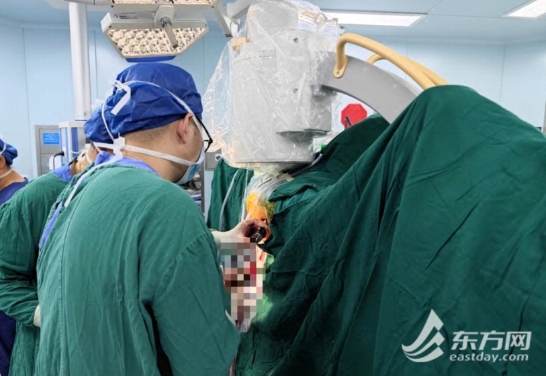- News
Shanghai General Hospital breaks the "age taboo" to save a centenarian patient with a femoral fracture surgery
https://j.021east.com/p/1720000377044021
On July 3, correspondents Hu Yang and reporter Liu Yilin from Eastday reported:
A centenarian patient with a femoral fracture urgently required surgical treatment. However, the patient’s extremely advanced age, coupled with fragile cardiopulmonary function and anemia, significantly increased the surgical risk. Confronting this challenge, a multidisciplinary team led by Chief Orthopedic Surgeon Dr. Li Haoqing at Shanghai General Hospital, in collaboration with the Departments of Anesthesiology, Rehabilitation, and the Operating Room Nursing Group, successfully performed a closed traction reduction and minimally invasive intramedullary nail fixation surgery within just 30 minutes, utilizing general anesthesia combined with nerve block anesthesia. After the surgery,, the treatment team closely monitored the patient's vital signs and indices, and following the procedure of “Enhanced Recovery After Surgery” (ERAS) initiated scientific rehabilitation exercises at the earliest opportunity. The patient is currently recovering well and is expected to be discharged soon.

This patient, Mrs. Pan, 100-year-old recently suffered a fall at home, resulting in severe pain and immobility in her right hip. Her family promptly brought her to the emergency department of Shanghai General Hospital. After completing the necessary examinations, Mrs. Pan was diagnosed with an intertrochanteric fracture of the right femur. Dr. Sun Dengshuo, who received her, immediately arranged for her hospitalization.
Intertrochanteric femoral fractures are among the most common types of hip fractures in the elderly. Due to the difficulty in caring for such fractures, patients are often unable to turn or sit up and require prolonged bed rest, leading to a higher incidence of complications such as pressure sores, venous thrombosis, and pneumonia. The mortality rate within a year can reach 30%-40%. Due to its high rates of disability and mortality, this type of fracture is often referred to as "the last fracture of one's life."
For patients like Mrs. Pan, timely and accurate assessment of the condition and early surgical intervention are the best methods to reduce mortality. However, whether a centenarian can tolerate the surgical procedure and anesthesia, and overcome potential postoperative complications and rehabilitation challenges, presents a significant dilemma for both the medical team and the patient. Since Mrs. Pan could mostly manage her daily activities and walked without difficulty, she had high hopes of walking normally again. In response to her expectations, the team led by Chief Orthopedic Surgeon Dr. Li Haoqing and Attending Physician Dr. Chen Jian decided to challenge the "age taboo" of performing surgery on extremely elderly patients.
The expert team conducted a comprehensive examination and evaluation of Mrs. Pan and discovered she had severe anemia, with hemoglobin levels below 7g/dL. The hospital immediately activated an emergency protocol to administer a blood transfusion to correct the anemia. After completing preoperative preparations and a thorough cardiopulmonary function assessment to confirm she met the surgical criteria, the expert team promptly scheduled Mrs. Pan for surgery.
Dr. Li Jinbao, the Chief of Anesthesiology, conducted a detailed evaluation of Mrs. Pan's overall condition and decided on a combination anesthesia plan of "general anesthesia combined with nerve block anesthesia." After successful anesthesia induction, the surgical team used a novel traction bed to perform closed reduction of the fracture, followed by minimally invasive intramedullary nail fixation. Under the meticulous care of the anesthesia team, the surgery was completed smoothly in just 30 minutes. The surgical incision was approximately 5 centimeters, with blood loss less than 100 milliliters. After anesthesia recovery, Mrs. Pan was able to engage in normal conversation.

The orthopedic team closely monitored Mrs. Pan’s vital signs after her operation. Head Nurse Zhang Guofeng led the nursing team in providing meticulous care, while the anesthesia team managed her pain. On the second postoperative day, Mrs. Pan experienced significant pain relief and was able to turn over independently. The rehabilitation team promptly intervened, guiding her through rehabilitation exercises to expedite her recovery. Currently, Mrs. Pan is recovering well and is expected to be discharged soon.
